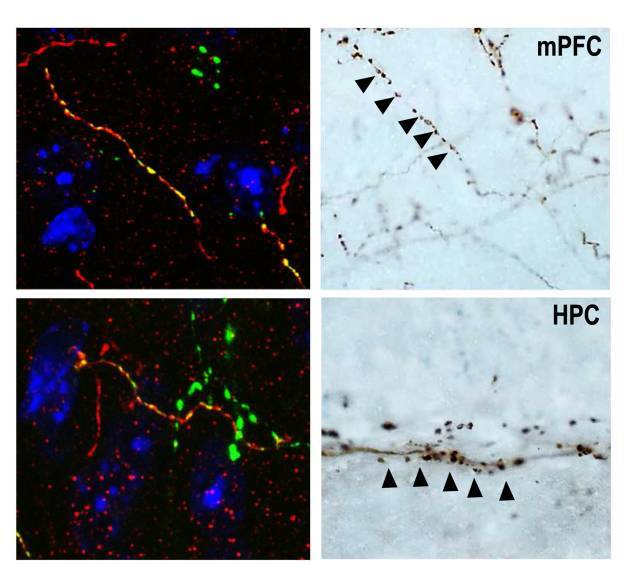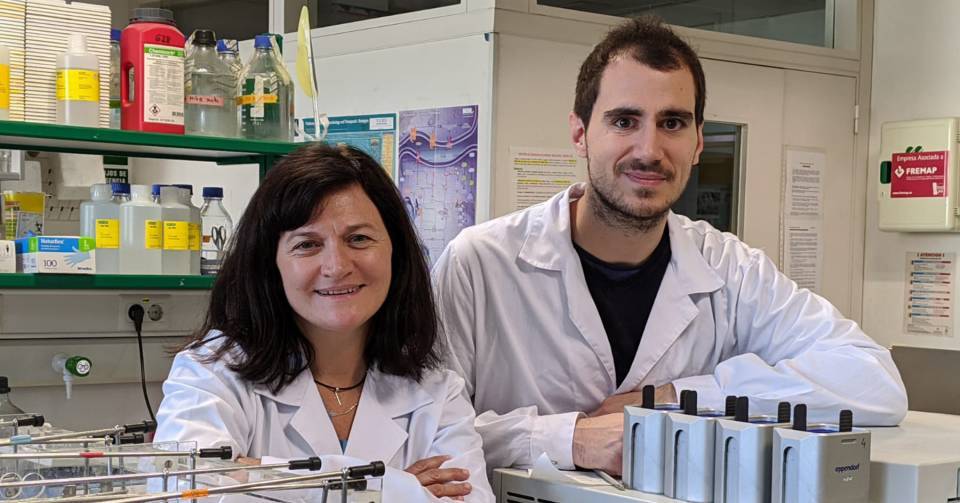Researchers at IDIBAPS and the CSIC’s Barcelona Biomedical Research Institute (IIBB) have developed a new preclinical model to study the non-motor symptoms of Parkinson disease. The model is based on the accumulation of the protein α-synuclein, one of the differential markers of Parkinson disease, in the serotonin neurons, which control emotion and mood.
The Nature journal Translational Psychiatry, published the study, led by Analia Bortolozzi, principal investigator of the IDIBAPS Systems neuropharmacology group, CSIC scientist at IIBB, and CIBERSAM researchers.
Beyond dopaminergic neurons
Increased expression of the protein α-synuclein and its accumulation in certain regions of the brain, known as Lewy bodies, constitute an early sign of activation of the cell mechanisms that, in the end, lead to the breakdown of the dopaminergic neurons. Deposits of α-synuclein, however, are not only observed in this type of cell; they also affect other circuits, such as the serotoninergic networks, which control emotion and mood.
Increasing evidence suggests that serotonin-producing neurons play a key role in the development of several motor symptoms, such as tremor and abnormal and involuntary movements; but they also play a role in the onset of anxiety, depression, anhedonia or lack of pleasure, and cognitive deterioration in early stages of the disease.
In fact, between 35% and 50% of Parkinson patients present anxiety and depression. This makes them the most prevalent neuropsychiatric symptoms. “The problem is that animal models for studying this have not yet been established, as very few studies describe the effects of anxiety and depression in mice that develop a phenotype similar to the disease”, explains Bortolozzi. Moreover, most of these studies focus mainly on the dopamine pathways and, therefore, probably do not reflect the real complexity of the processes taking place in patients’ brains.
A new model for neuropsychiatric symptoms
In its study, Bortolozzi’s team generated a “humanized” mouse model that overexpresses the human form of the alpha-synuclein protein in the serotoninergic neurons. This alters the structure of the axons in brain regions regulated by serotonin, which leads to the loss of function of synaptic markers, reduced serotoninergic neurotransmission, and the onset of depressive/anxiety behavior.

Images obtained by means of confocal microscopy (left) of serotoninergic fibers with abundant content of the protein α-synuclein in mouse prefrontal cortex and hippocampus. On the right, images representing structural changes (“swelling”) of the axons that accumulate alpha-synuclein in the same brain regions.
Moreover, in collaboration with the biotechnology company Lingea MC, the researchers designed a treatment to reverse these brain abnormalities. Specifically, they synthesized a new oligonucleotide sequence against human alpha-synuclein, which they combined with a small molecule called indatraline. Indatraline presents strong afinity for a membrane transporter selectively located in the serotoninergic neurons. This ensures that the oligonucleotide is aimed at and acts specifically on these neurons.
According to the results, after four weeks of direct administration in the ventricles of the brains of mice, the treatment reduced excess synthesis and accumulation of α-synuclein in the serotoninergic neurons and in the interconnected areas of the brain, such as the prefrontal cortex, hippocampus, and striatum. This led to recovery of normal serotonin transmission and alleviated the symptoms of depression and anxiety associated with the α-synuclein pathology, which appear in the initial stages of the disease, even when there is no neuron loss.
Bortolozzi explains that the next step is to identify functional connectivity between the affected emotional circuits in order to establish new therapeutic targets. The researchers will also study the differences in connectivity between the sexes, as male mice with an accumulation of α-synuclein show greater vulnerability to stress situations, whereas females present anxiety and loss of pleasure. To this end, the first experiments, in collaboration with researchers from the IDIBAPS magnetic resonance imaging platform, have already begun.
The study also involved the participation of scientists from the Networked Biomedical Research Centre on Mental Health (CIBERSAM) and Neurodegenerative Diseases (CIBERNED), from Universidade Federal do Paraná (Brazil), the Vall d’Hebron Research Institute (Barcelona), and the Catalan Institute for Research and Advanced Studies (ICREA).
Reference article
Lluís Miquel-Río, Diana Alarcón-Arís, María Torres-López, Valentín Cóppola-Segovia, Rubén Pavia-Collado, Verónica Paz, Esther Ruiz-Bronchal, Leticia Campa, Carme Casal, Andrés Montefeltro, Miquel Vila, Francesc Artigas, Raquel Revilla, Analia Bortolozzi. Human α-synuclein overexpression in mouse serotonin neurons triggers a depressive-like phenotype. Rescue by oligonucleotide therapy. Transl Psychiatry. 2022 Feb 24;12(1):79. doi: 10.1038/s41398-022-01842-z.




